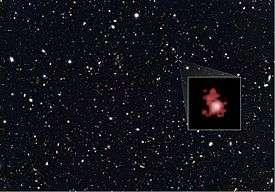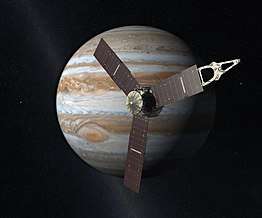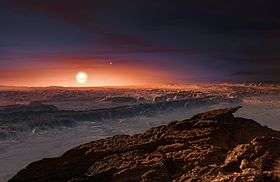1994 WR12
1994 WR12 is a sub-kilometer asteroid, classified as near-Earth object of the Aten group, approximately 130 meters in diameter.[1][4] First imaged at Kitami Observatory on 26 November 1994,[3] the asteroid was discovered two nights later by American astronomer Carolyn S. Shoemaker at Palomar Observatory on 28 November 1994.[2] It then went unobserved from 1994 until it was recovered by Mauna Kea in March 2016.[3] It was removed from the Sentry Risk Table on April 2, 2016.[5]
| Discovery [1][2][3] | |
|---|---|
| Discovered by | C. S. Shoemaker |
| Discovery site | Palomar Obs. |
| Discovery date | 28 November 1994 |
| Designations | |
| 1994 WR12 | |
| Aten · NEO [1] | |
| Orbital characteristics [1] | |
| Epoch 4 September 2017 (JD 2458000.5) | |
| Uncertainty parameter 1 | |
| Observation arc | 21.35 yr (7,797 days) |
| Aphelion | 1.0575 AU |
| Perihelion | 0.4560 AU |
| 0.7568 AU | |
| Eccentricity | 0.3974 |
| 0.66 yr (240 days) | |
| 342.66° | |
| 1° 29m 49.56s / day | |
| Inclination | 6.8588° |
| 62.701° | |
| 206.00° | |
| Earth MOID | 0.0019 AU · 0.7 LD |
| Physical characteristics | |
| Dimensions | 130 m (est.)[4] |
| Mass | 2.9×109 kg (est.)[4] |
| 22.3[1] | |
Description
1994 WR12 orbits the Sun at a distance of 0.5–1.1 AU once every 8 months (240 days). Its orbit has an eccentricity of 0.40 and an inclination of 7° with respect to the ecliptic.[1]
It has an Earth minimum orbital intersection distance of 0.0019 AU (284,000 km), which translates into 0.7 lunar distances.[1] On 25 November 2046, it will pass 0.0108589 AU (1,624,470 km) from Earth with an uncertainty of ±800 km.[6] While listed on the Sentry Risk Table the range for the 2046 close approach distance varied from 0.001 AU (150,000 km) to 0.039 AU (5,800,000 km) from Earth.[6]
While listed on the Sentry Risk Table,[7] virtual clones of the asteroid that fit the uncertainty in the known trajectory showed 116 potential impacts between 2054 and 2109.[4] It had about a cumulative 1 in 9090 chance of impacting the Earth.[4] The formerly poorly known trajectory of this asteroid was further complicated by close approaches to Venus and Mercury.[6] It was recovered by Mauna Kea in March 2016,[3] which extended the observation arc from 34 days to 21 years.
It is estimated that an impact would produce the equivalent of 77 megatons of TNT,[4] roughly 1.5 times that of most powerful nuclear weapon ever detonated (Tsar Bomba).
See also
- Lost asteroids
References
- "JPL Small-Body Database Browser: (1994 WR12)" (2016-04-01 last obs.). Jet Propulsion Laboratory. Retrieved 2 August 2017.
- "MPEC 1994-Y05 : 1994 WR12". IAU Minor Planet Center. 21 December 1994. Retrieved 17 October 2011. (J94W12R)
- "1994 WR12 Orbit". Minor Planet Center. Retrieved 2 August 2017.
- "Archive: Earth Impact Risk Summary: 1994 WR12". NASA/JPL Near-Earth Object Program Office. 26 March 2016. Archived from the original on 26 March 2016.
- "Removed Objects". NASA/JPL Near-Earth Object Program Office.
- "JPL Close-Approach Data: (1994 WR12)". Retrieved 7 April 2011.
"(1994 WR12)". Archived from the original on 13 December 2012. Retrieved 29 January 2018. (last observation: 1994-12-31; arc: 35 days; Uncertainty: 8) - "Archive: Sentry Risk Table". NASA/JPL Near-Earth Object Program Office. 29 May 2013. Archived from the original on 29 May 2013.


